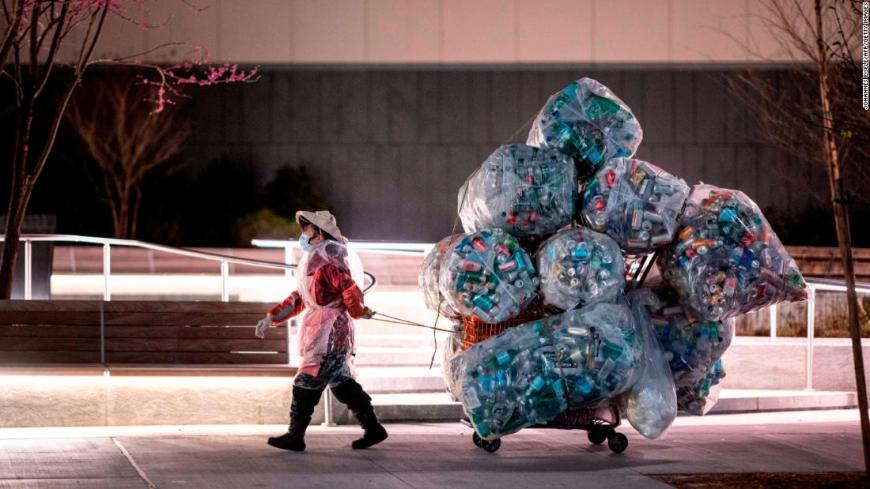A lot of people say that COVID has improved the environment. Sure, that is a fair argument, because with COVID roaming around the cities, people travel less, so there is a significant improvement in air quality. Plus, the noise pollution level has considerably died down. There is a lot of data and evidence that proves the statement about the positive effect COVID has on the environment. However, COVID might not be as friendly to the environment as it seems.
DISPOSABLE MASKS: PLASTIC IN DISGUISE
Quite a lot of people have the assumption that disposable masks are made of eco-friendly materials. This is a valid guess, since the inner layer of the mask is made of cotton. However, the reality is that disposable masks are mostly made of polymer.
Polymer refers to substances made of very large molecules. For example, protein is a kind of polymer. Polypropylene is especially suitable for making masks because it is considered to be safer than most polymers. Since the polymers used in masks are considered plastic, the masks are disguised plastic. Therefore, disposable masks are not as eco-friendly as you think they are. Because of COVID, disposable masks are very often required and discarded, which adds on to the plastic flood.
Marine plastic waste. Source: World Economic Forum
WHAT CAUSED THE PLASTIC OVERFLOW IN COVID?
So is the plastic disaster only caused by the huge amounts of disposable masks? Of course not. We are going to look at what could affect the plastic flood specifically in COVID.
- The need for single-use plastic boosted during COVID. During quarantine, while everyone stays at home, a lot of people are going to use food delivery or take out services. There is absolutely no way that people would go out without masks. Also, because people would want cleaner services that haven’t been touched or used by others, the use of single-use plastic can increase in a lot of areas. The amount of single-use masks used every minute in the world could almost cover a polo field. So, increased delivery services, the need for disposable masks and the need for using cleaner plastic could increase the amount of plastic used and discarded.
- Recycling systems stopped functioning normally during COVID. Due to the dramatic increase of discarded plastics, the recycling system is being overwhelmed. Strict social distancing measures impede recycling workers to work as effectively, however these workers are fatal to the recycling system. Moreover, every country needs more budget to fight the virus and prevent the spread, ergo, the budgets for recycling are naturally not as high as usual.
- Oil prices plummeted because of the drop in demand during the pandemic. People aren’t traveling that much during COVID, thus there are far fewer demands for oil than normal times. One of the main materials to make plastic is oil. Therefore, because of the drop in oil prices, plastic has become cheaper so that they are convenient and more affordable.
WHAT CAN BE DONE TO EASE THE SITUATION?
Of course, there is something that can be done to help minimize the impact, and that is that we solve this problem from the source. Do you ever wonder how plastic is made? That is the answer we need from all the companies and mask manufacturers. If we can make the manufacturing process transparent to the public, we could come up with more eco-friendly solutions to making plastic. We might even figure out an alternative to some of the materials. This also allows the government to eliminate unnecessary processes, improve the recycling system and take other measures to mitigate the impacts from the manufacturing process on pollution. Most importantly, we can also be part of the action.
“Each one of us can make a difference. Together we make change.”
— Barbara Mikulski
An easier solution that doesn’t require official processes is to reduce plastic waste. When you call a delivery service, buy as much as you can in a single purchase instead of multiple ones and if you are ordering a meal, tell them that you do not need plastic forks or spoons or any tablewares if you can use your own. If you can, use reusable masks (they are effective too). If you go out shopping, bring your own reusable bag. Share your actions to inspire others and raise awareness via social media or other platforms. These are all simple actions yet if they are all implemented on a bigger scale, miracles could happen!
CONCLUSION
To wrap it all up — COVID is in some aspects improving the environment, but if we take the plastic flood into consideration, the environmental effects are much more alarming. This plastic crisis could be caused by the increase in needs, the malfunction of the recycling systems, and the decrease of oil prices. Making the manufacturing process more transparent can mitigate the effects, but simple actions to reduce plastic waste in our daily lives can make a huge difference as well.
Sources
Impact of COVID-19 pandemic on waste management. Retrieved from https://link.springer.com/article/10.1007/s10668-020-00956-y
From the barrel to the pump: the impact of the COVID-19 pandemic on prices for petroleum products. Retrieved from https://www.bls.gov/opub/mlr/2020/article/from-the-barrel-to-the-pump.htm#_edn3
Face masks and the environment: Preventing the next plastic problem. Retrieved from https://www.sciencedaily.com/releases/2021/03/210310122431.htm
How face masks, gloves and other coronavirus waste is polluting our ocean. Retrieved from https://www.weforum.org/agenda/2020/06/ppe-masks-gloves-coronavirus-ocean-pollution/
Coronavirus is causing a flurry of plastic waste. Campaigners fear it may be permanent. Retrieved from https://edition.cnn.com/2020/05/04/world/coronavirus-plastic-waste-pollution-intl/index.html


Published by